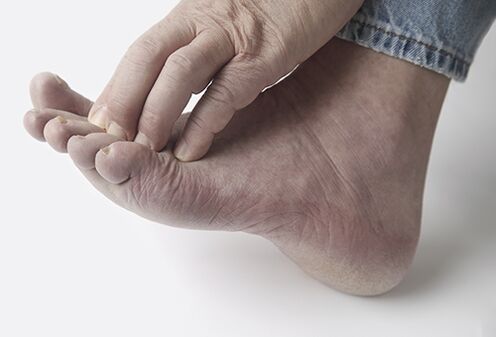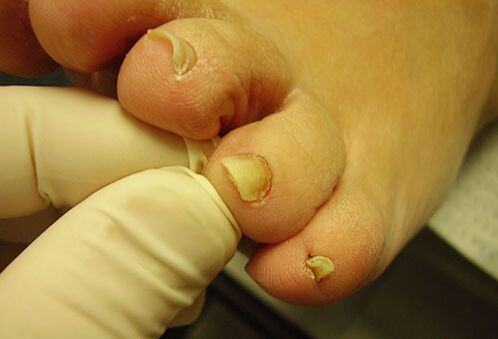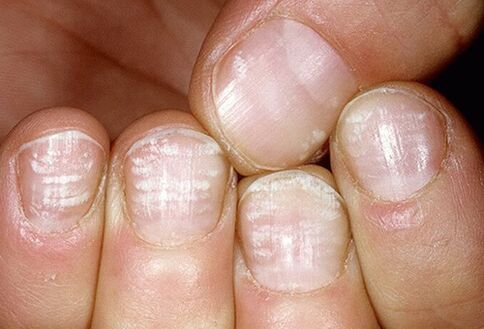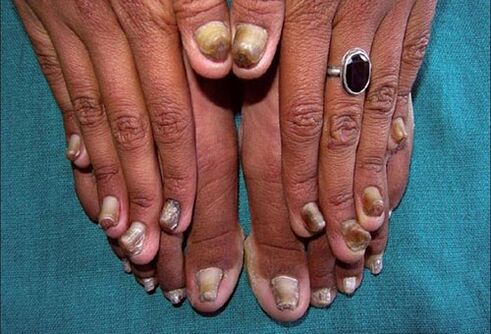Nail fungus should not be confused with anything at an advanced stage, when it is almost impossible to cure it. But if you know the symptoms of nail fungus early, then it won’t be too late to start fighting the infection, and nail loss may be preventable. But in different cases, the fungus looks different, so first you need to understand a little about the nature and course of the disease.

General signs of the disease
Regardless of the type of fungus, its diversity, the course of the disease, and even the stage, these symptoms will remain unchanged and will certainly indicate onychomycosis that is developing or is already underway.
- A change in the color of the nail plate is a major sign of where the disease is starting to develop. Colors can range from whitish to black, but the most common fungal nail color is brownish yellow.
- Unpleasant odors always accompany onychomycosis, although it may not be so noticeable in the early stages. True, you will hardly sniff on your feet, and certain odors will be noticeable at the stage of development of the disease.
- Stratification, collapse and exfoliation of nail plates do not begin immediately, but it is these signs of nail fungus that make most people sound the alarm. If these symptoms are expressed in moderation and appear locally, then there is still a chance to restore a healthy look to the nails.
- Painful sensations rarely appear in the early and developmental stages, but as the disease progresses, discomfort and pain are inevitable: in any case, they will appear either due to deformation, or due to destroyed nail plates, or due toby the onset of inflammation with pus.
- Burning and itching on the skin should also not be ignored. Moreover, in the early stages, these symptoms can help recognize the disease, because in some cases it passes through the nail plate from the skin on the lateral or posterior ridge or cuticle.
By the way
Onychomycosis is more common on the toenails, while the fungus is less common on the hands, most often after contact with the affected toenails.

Symptoms of foot fungus
It seems that you already know how to identify nail fungus, but this information is quite general, although it will help to diagnose onychomycosis accurately. The fact is that there are more than 50 species of fungi that can cause it, and about 10 of the course of the disease. It is better to know what awaits you in each possible scenario in advance.
More than 90% of all cases of infection with onychomycosis of the feet are due to dermatomycetes, slightly less than 10% - to yeast -like fungi, and only a small fraction - to fungal formation.
Different types of nail fungus give different symptoms.
- With normotropic fungi, the nail plate itself is not deformed, and the most noticeable manifestation of the disease is the discoloration of the plate on the side to a yellowish brown. At the same time, its thickness does not change, it does not crumble, and the natural gloss is not lost. If you do not deal with normotropic fungal treatment, it will affect the growing area, the plate will start to peel off and may come off completely.
- Hypertrophic fungi cause a thickening of the nail plate, which leads to the formation of growths that look like nails. At a later stage, such fungi cause discomfort and often pain when walking, and, of course, nail damage is accompanied by a change in color to gray or yellow. Such nails lose their natural luster and begin to crumble and flake off.
- If you are dealing with atrophic fungus, then the risk of losing the plate without proper treatment is very high. Such fungi gradually destroy the nail plate, making it loose and flaky, as a result of which atrophy occurs. In the early stages, it is difficult to distinguish the atrophic course, as it is accompanied only by loss of luster and discoloration of the plate to yellow, brown or gray.
Less typical is lateral-distal mold with blackening of the nail plate, pain, pus and atrophy of the nail plate at an advanced stage; proximal fungi with white spots in the growth zone area and damage to the nail plate from the side of the cuticle, as well as white superficial fungi, which manifest themselves in the form of small white spots on the nail, grow gradually and occupy the growing area.
By the way
The older a person is, the more prone to fungal nail disease. Also, the incidence of fungi can be influenced by climate, hygiene and gender.

Symptoms of fungus on the hands
On the hands, the 3 main variants of the disease course do not differ from those found on the feet, only the distribution of causes is quite different: about 30% and 45% are caused by dermatomycetes and yeast-like. fungi, respectively, slightly less than 15% are molds, as well as a small number of infections caused by other mycotic organisms.
The main symptoms are also the same for plates on the arms and legs, and the affected areas look similar. The only difficult thing may be the question of how to recognize nail fungus in less frequent cases, such as rubromycosis or trichophyton infections, but this is more of a task for a qualified physician.

Fungal development
If in the early stages of the disease does not seem daunting and the thought of serious treatment is seldom visited, increasingly replaced by folk methods, then at a later stage it will not be possible to do without long -term medical treatment. And even it won’t be able to guarantee that the nail will stay with you.
- It is ideal to start treating the disease at an early stage, but it is almost impossible to determine it outside the laboratory: all symptoms have almost insignificant manifestations. Although some signs can still be seen. If you notice something wrong with the skin, for example, cracks, blisters or burns may appear, this is a clear sign of onychomycosis on the nail. If you notice that the color of the nail plate has started to change along the edges or from one edge, this is also worrisome.
- Usually, the fungus becomes noticeable at the developmental stage, and to see it as early as possible, you need to regularly do at least a simple pedicure and monitor the condition of the nails and skin of the feet. During this period, the nail plate looks unhealthy, loses its luster, significant changes in color begin, and closer to the beginning of advanced stages, the nail begins to deform, flake off and crumble.
- At a later stage, the nail will inevitably actively collapse: delaminate, break, loosen until the entire destruction of the nail plate and even damage to the nail bed. In order for the disease to reach its advanced form, it must be ignored for quite some time, withstanding the itching, discomfort, disgusting appearance and unpleasant odor, which are still rarely done by the public. Therefore, this stage is typical for the rapid development of the fungus in old age or with the presence of certain diseases.
It is important to remember that untreated nail fungus can turn into foot fungus, and the disease is more unpleasant and difficult to treat.
It is not so difficult to determine the presence of fungus on the nails at least at the developmental stage, but it is better to trust a qualified professional to determine the cause and type of course. Do not neglect the help of doctors and contact them when the first suspected disease.
























